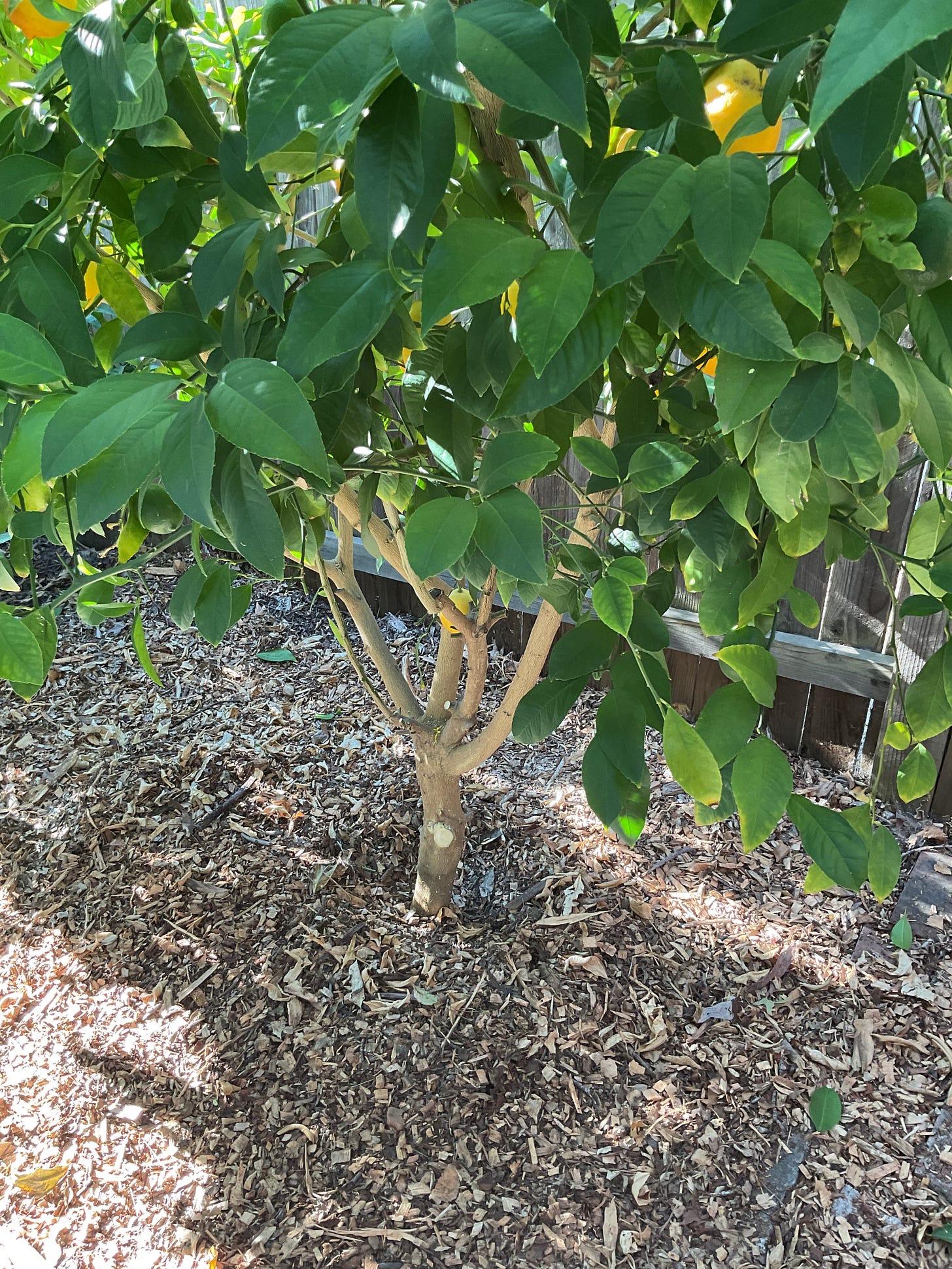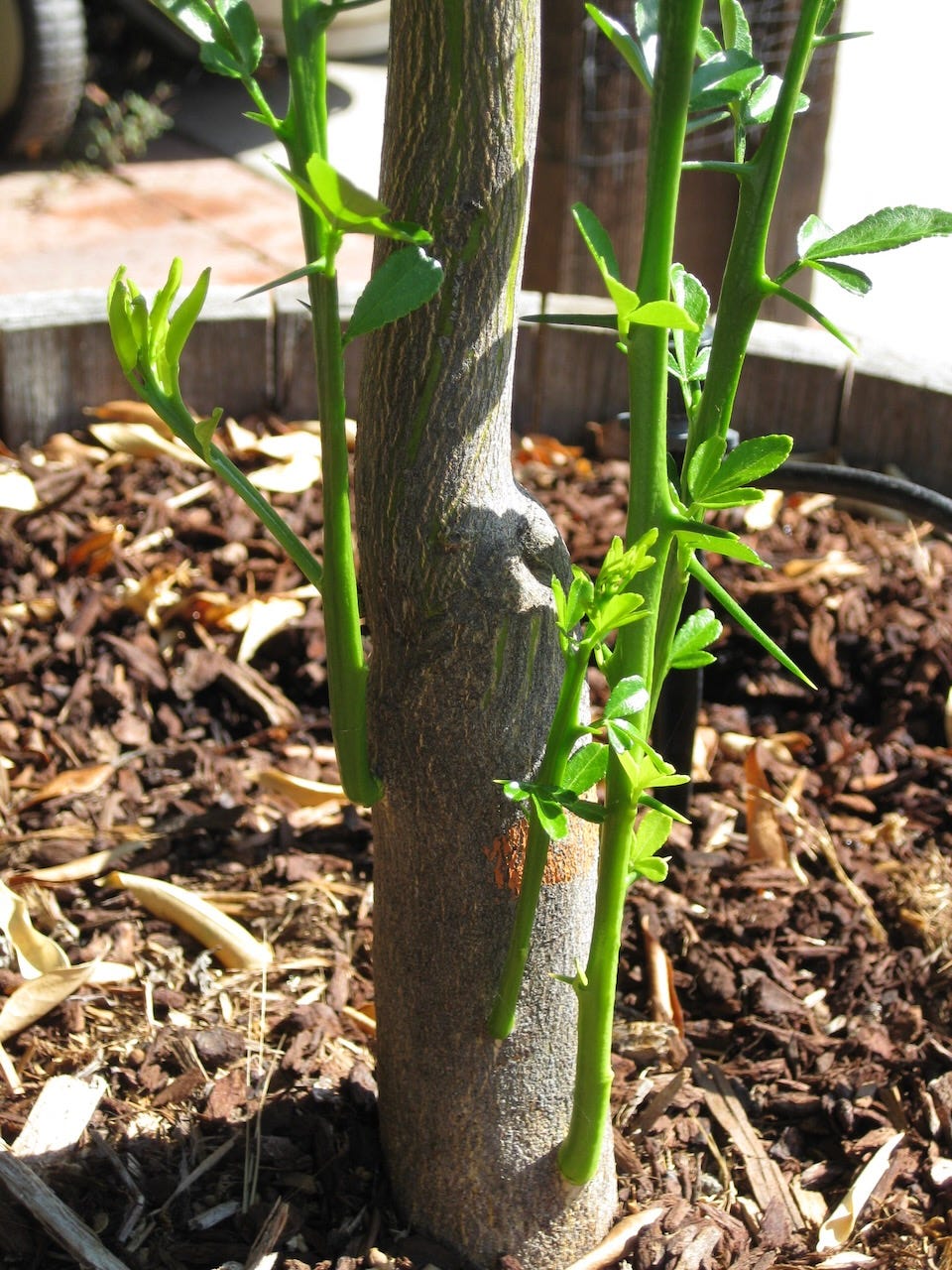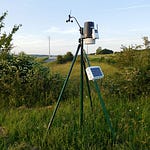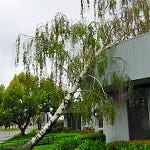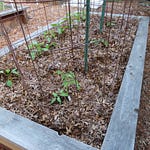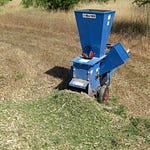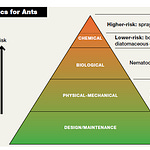In today’s newsletter podcast, fruit tree expert Ed Laivo of Ed Able Solutions gives us tips for dealing with varmints that get to your tree fruit before you’ve had a chance to sample it. And, he has tips for growing fruit trees in containers. I mentioned in the podcast that we would have a video link to Ed’s Harvest Day 2024 presentation at the Fair Oaks Horticulture Center on August 3, which was about growing fruit trees in containers. That video is not yet available; but here, enjoy Ed talking about that topic on his YouTube page.
In the typed remarks below, we get into another way to thwart the crawling, walking, hopping, flying pests that get into your fruit trees, and that is to skirt prune those trees that have low hanging branches, that reach the ground.
For those of you who were hoping for stories of the high school girls at U.S. Grant High School in Van Nuys who would surreptitiously raise the hem of their mandatory skirts above the knee near the end of lunch period because the vice principal would leave the premises after one lap through the cafeteria area, sorry. And yes, it was a public school. And yes, skirts were mandatory for the female students. Except for one school day a year (Senior Day) in June, when the senior girls got to wear slacks (but not blue jeans!). How long ago was that? An up and coming band was the entertainment in the high school auditorium that Senior day, Three Dog Night.
When to Prune, When Not to Prune, Citrus Trees
If your citrus trees – the oranges, lemons, limes, mandarins, grapefruit, and more – are looking a bit overgrown and bushy, pruning can help reinvigorate them to produce more fruit. But don’t prune them now.
Cindy Fake is the Horticulture and Small Farms Advisor for the University of California Ag and Natural Resources in Placer County, who wrote their “Pruning Citrus” webpage. She agrees there are benefits to pruning citrus trees, but the timing is important.
“Citrus trees are evergreen trees, generally requiring less pruning than deciduous trees. However, they do need to be pruned regularly for optimal fruit quality and productivity. Pruning can improve fruit quality through increasing light in the canopy. In some cases, pruning out water sprouts (vertical shoots) may improve yields. Reducing tree height facilitates harvesting as well as risk of injury from ladders.”
However, Fake adds: “Pruning citrus trees is best accomplished in spring and early summer, after it sets flowers and then again when the small fruit appears.”
Retired citrus grower Lance Walheim, author of the book “Citrus”, seconds that motion. “Late summer and early fall citrus pruning is discouraged. Late pruning often stimulates vigorous tender growth, which doesn't have enough time to harden off before cold weather, increasing chances of frost damage. Pruning in late summer, especially here, where triple digit temperatures are common, can cause citrus bark and fruit to become exposed to too much intense sunlight. Citrus bark is highly sensitive to sunburn. The bark can be killed, which can girdle the tree, especially if the tree is in a south or west exposure. Whenever bark is newly exposed to intense sunlight, paint the exposed area with a whitewash, made of 50% water and 50% interior white latex paint.”
However, there are a few minor citrus pruning chores that can be done anytime of the year: removing the suckers that begin below the bud union just above ground level; and skirt pruning the citrus tree. “Skirt pruning” is exactly what it sounds like, removing any branches that reach the ground.
“Skirt pruning facilitates weeding, mulch laying, and other cultural practices, as well as reducing risk of soil borne pathogens affecting the fruit,” explains Fake. “The pruning may also reduce insect and disease pest problems.”
And, as Laivo points out in the podcast, netting the tree can be a somewhat effective pest deterrent, especially if you drape the netting completely over the tree to the ground, and tie it around the trunk of the tree. Try doing that with a non-skirted tree!
Fake says to keep an eye out for low-lying branches on mandarin trees, especially. “Satsuma mandarins tend to have pendulous branches that hang to the ground. These are called skirt branches, and they can impede weeding, fertilizer, and compost application, as well as provide pathways for ant populations to use the trees. With heavy fruit loads, these branches can bend, and fruit may touch the ground. Fruit may then be contaminated by soil borne pathogens. These pathogens may be plant disease-causing such as Brown rot, or potential food safety risks.”
The Department of Agriculture and Food in Western Australia (actually, it’s the Department of Primary Industries and Regional Development) offers these reasons for commercial growers of citrus to skirt prune their citrus trees (warning: their dates are for the Southern Hemisphere, where summer there is winter here and winter there is summer here):
Skirting (skirt pruning)
Skirting is the removal of branches and limbs which hang down to the ground. It should be done as soon after harvest as possible.
Skirting of Valencias and summer navels is more difficult as the trees are carrying two crops. Some crop loss is inevitable whenever late varieties are skirted. Skirting in October or November after fruit set is probably the best option.
Mature trees should be skirted to a height of at least 75cm (29 inches). This allows for branches dropping lower when fruit develops. Machine skirting is quick and easy (I didn’t see any tree skirting machines on Amazon, but they did have a parking lot striping machine!).
Skirting provides the following advantages:
better air movement under the trees
easy application of below-tree herbicides and fertilizers
reduced access into the tree for insects and pests such as Fuller’s rose weevil and snails
clear throw of irrigation water from mini-sprinklers and ease of checking on the operation of mini-sprinklers and drippers
no splashing of soil-borne fungi into the canopy from rain or irrigation
better access when harvesting
prevents lower set fruit from hanging in the dirt
required practice as part of the market access protocol for some export markets.
Dress for the Occasion
As a general rule, Citrus trees should be skirted up about 18 to 24 inches above the ground every couple of years.
And before you tackle any pruning chores with citrus, Walheim says to dress for the occasion.
“Before you prune citrus, take measures to protect yourself from the sharp thorns, warns Walheim. “Wear thick gloves, a long-sleeved shirt (or thorn-resistant sleeves) and protective glasses. Wear a hard hat, too.”
Young citrus trees are especially prone to gangly growth says Walheim. “These younger citrus trees produce highly vigorous shoots, the water sprouts, that give the tree and unkempt, out of balance appearance. These shoots can be cut back to maintain a more uniform shape. Also, remove suckers that originate from below the graft union, known as the suckers. They are nonproductive and only sap strength from the tree.”
During prime citrus pruning time – late winter and early spring – that’s the best time to control the height of your citrus trees.
“The most vigorous types of citrus trees, especially lemons, are often trimmed or cut back 20 to 30 percent every year or two,” says Walheim. “Keeping the centers of citrus trees open by selectively thinning branches (the total removal of the branch) can improve their health. Remove branches that crisscross or crowd one another; prune out any dead limbs. By allowing sunlight to reach the center of the tree, the inner portions remain productive.”
Skirt pruning is also a good idea for deciduous fruit trees, as well, Removing low hanging branches as well as any rootstock suckers from peach, nectarine, pear, apple, cherry and more fruit tree varieties makes it a heck of a lot easier for monitoring your irrigation system, applying fertilizer, weeding, cleaning up fallen fruit, and spreading mulch.

Thanks for reading Beyond Basics: The Garden Basics with Farmer Fred Newsletter! Subscribe for free to receive new posts and support my work.
Thank you for also listening to the Garden Basics with Farmer Fred podcast! It’s available wherever you get your podcasts. Please share it with your garden friends.
Fred Hoffman is also a University of California Cooperative Extension Master Gardener in Sacramento County. And he likes to ride his bike(s).




